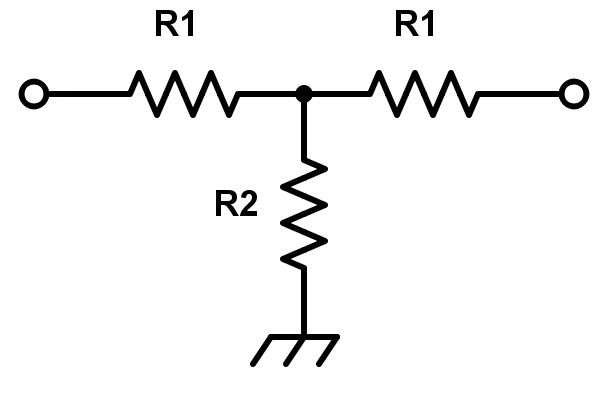This calculator helps you determine the values of the resistors R1 and R2 to be used for a T-pad attenuator.
Outputs
Overview
This calculator is designed to help calculate the value of the resistors R1 and R2 to be used in T-pad attenuator. The user only needs to enter the attenuation in decibels (dB) and the given characteristic impedance of the transmission lines to be matched.

Equation
$$R_{1}=Z_{0}\left [ \frac{10^{\frac{A_{dB}}{20}}-1}{10^{\frac{A_{dB}}{20}}+1}\right ]$$
$$R_{2}=2Z_{0}\left [ \frac{10^{\frac{A_{dB}}{20}}}{10^{\frac{A_{dB}}{10}}-1}\right ]$$
Where:
$$R_{1}$$ = T-pad attenuator resistor 1
$$R_{2}$$ = T-pad attenuator resistor 2
$$Z_{0}$$ = transmission line characteristic impedance
$$A_{dB}$$ = desired attenuation in dB
Applications
An attenuator is a passive network, designed to weaken the power being supplied from a source circuit to a level suitable to the destination circuit. The theory behind attenuators comes from the voltage divider principle.
In RF applications, it is normally desired to use an attenuator to reduce signal levels from one point in the network to the other. Besides this, attenuators are also used to match impedances between two circuits in order for maximum power transference. Attenuators can also be used to isolate two different circuit stages.
The T-pad attenuator is one of the more common passive attenuators used in RF applications. The advantage of this network over other topologies is its simple construction. It is easier to etch out a T-pad network on a thin film circuit compared to etching a balanced or bridged-tee attenuator circuit.
See Also
Bridged-Tee Attenuator Calculator
Balanced Attenuator Calculator
Reflection Attenuator Calculator
Further Reading
Textbook - Attenuators: Amplifiers and Active Devices






1 CommentLogin
The formula for R2 is wrong! The K factor in the denominator should be “squared”
Thanks for pointing that out. I fixed it (by changing the exponent’s denominator to 10 instead of 20).